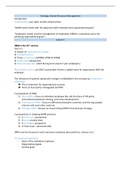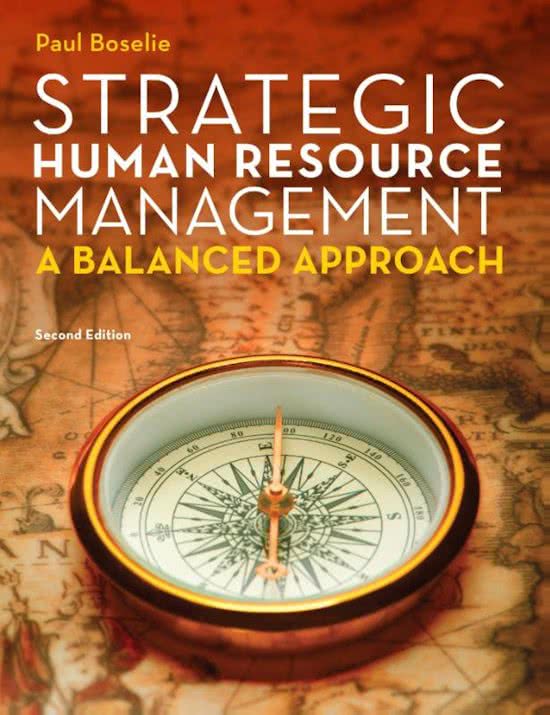Strategic Human Resource Management
Introduction:
Employability, your labor market attractiveness
“SHRM had to deals with the alignment with individual and organizational goals.”
“employees matter and the management of employees (HRM) is a potential source for
achieving organizational goals.”
Lesson 1
HRM in the 21st century
The 5 I’s
1) Impact of organizational change
2) Competitiveness
3) Three perspectives (MHRM, IHRM & SHRM)
4) Stakeholder perspective
5) Balanced approach (short & long term view for your employers)
*Sustainable careers are ONLY sustainable if there is added value for organization AND the
employer.
The relevance of optimal coping with change is embedded in the concept op competitive
advantage.
è This is important for organizational survival;
è And is at least partly manageable by HRM.
3 perspectives of HRM
1) Micro HRM – focus on individual employee like sub functions of HR policy
(recruitment/selection) training, and career development.
2) International HRM – focus on differences between countries, and the way people
interact with each other (culture).
3) Strategic HRM – focuses on issues linking HRM to the business strategy.
3 perspectives in studying SHRM practices
1) A multi-actor perspective
2) A broad societal view
3) A multi-level perspective
4) A Team level – advanced skills
HRM must be focused on each and every employee (also parttime, cleaners etc.)
The balanced approach:
- Goals of the individual employee
- Organizational goals
- Societal goals
, Lesson 2
Chapter 2 Boselie’s
“The more fit (alignment) the better”
- How does the environment impact the organization?
- What is relevant in light of our purpose (WHY), mission (HOW) and vision (WHAT)?
- Enactment is needed -> scan the environment, how envision the future?
- Misfits cost a lot of money and reduce individual and societal well-being.
Multiple fits in SHRM
1) Internal/horizontal fit;
a. HR system approaches all HR practices together, this results in higher
performance. *There are 4 linkages:
2) Vertical/strategic fit;
a. “best-fit” that assumes a necessary alignment between the overall business
strategy and the HR strategy.
3) Institutional fit;
a. Focused on the link between HR strategy and institutional environment of the
organization.
4) Organizational fit;
a. Fit between HR strategy and organizational systems.
5) Person-environment fit.
a. Person-job fit & person & organization fit
Strategy = An organization’s intention to achieve certain goals through planned alignment
(fit) between the organization and its environment.
o Goal-based strategy: based on the organizations vision (what) and mission
(how) (inspired by its purpose, beliefs, and values=why).
o Strategic formulation: is the process of forging a cohesive integrated set of
strategies designed to deal with the environment and achieve the business
strategic goals.
o Strategy implementation: is the actions the organization takes to execute the
strategy it has formulated.
,Environment
- General environment; social trends, political climate, national culture etc.
- Business environment; customers, the economy, technology, competitors etc.
SWOT analyzes
- Focus on an organizational field: A community of organization that partakes of a
common meaning system and whose participants interact more frequently and
fatefully with one another than with actors outside the field.
- What influence can other organizational fields have to you?
- Competitive strategy = markets to enter & how to compete them?
- Financial strategy = how to fund the business?
- Operational strategy = which supplies, technology & methods?
- HR strategy = how to recruit, organize, develop & motivate people?
Extent of strategic choice available to firms?
Strategic choice = the degree of leeway in strategic decision making in HRM.
1. Hyper-determinism; no leeway for strategic choice because of contextual conditions.
2. Hyper-voluntarism; free to do what you want, no restrictions for decision making.
“How can an organization try to change institutional pressures?” – lobbying, advertising etc.
The Harvard vs Michigan approach
- The stakeholder interest is considered in this model.
* Reproduced with permission from Beer
, Beer went ‘back to the future’
- Normative value-based framework
- Strategic value proposition (meaningful work)
- Wider, more contextual, multilayered approach founded on the long-term need of
multiple stakeholders.
- Constant enactment of organizational environment.
Also, institutional (values, outlines in legalization) mechanisms that affect HRM:
3 things that affect HR, with as a result…
Coercive pressure – (legal rules) implementation because of institutional forces
Normative pressure – a group of professional communities with their own values have
impact on how HR acts. The professionalization of an employee category does affect HRM
policies.
Mimetic pressure: imitation because of uncertainty, imitations because of trends/hypes.
*There is a dominant coalition of stakeholders in and outside the organization (unions) who
can influence the choices.
* you need to consider that people have an opinion about what is right.






